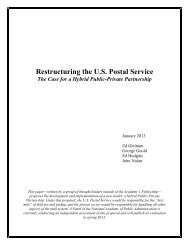High-Performance Partnerships - National Academy of Public ...
High-Performance Partnerships - National Academy of Public ...
High-Performance Partnerships - National Academy of Public ...
You also want an ePaper? Increase the reach of your titles
YUMPU automatically turns print PDFs into web optimized ePapers that Google loves.
SURVIVING TRANSITIONS<br />
IN LEADERSHIP<br />
The Challenges<br />
Working in the public, nonpr<strong>of</strong>it, and civic sectors<br />
presents significant demands. Politics, promotions,<br />
transfers, and burn-out can cause individuals<br />
to leave their leadership positions.<br />
Departures can be swift. It is not uncommon<br />
for a partnership’s leadership team to turn over<br />
in the first few years. Sustaining leadership over<br />
time is a formidable challenge.<br />
A successful partnership creates a sense <strong>of</strong> joint<br />
ownership that lessens the adverse ramifications<br />
<strong>of</strong> leadership transitions. When an initial champion<br />
moves on, others emerge because the partnership<br />
has taken proactive steps to decentralize<br />
authority and responsibility. As the partnership<br />
becomes more mature, it can recruit others from<br />
the community. Of course, early successes also<br />
help to sustain a leader’s participation, as well as<br />
the partnership’s energy and attractiveness.<br />
Leadership changes can be a double-edged<br />
sword for cross-sector partnerships. An inspirational,<br />
directive leadership style is effective in<br />
creating a partnership because it helps get critical<br />
steps organized and under way. However, as<br />
the partnership becomes “institutionalized,” it<br />
should become less dependent upon personality-driven<br />
leadership. It must assess the leadership<br />
skills needed at a given point in time and<br />
not be reluctant to make adjustments.<br />
FIGURE 5-3<br />
AVOIDING BURNOUT<br />
Leadership change should be considered in its most<br />
comprehensive context. Succession planning should<br />
occur at every level and for every partner. For<br />
example, when MCCP’s key HMO contact retired,<br />
he identified, mentored, and prepared his successor.<br />
He made sure that the successor shared the partnership’s<br />
philosophy and had the ability and authority<br />
to carry the message inside and outside the HMO<br />
(and get results!).<br />
The Strategies<br />
Leadership change is not necessarily bad.<br />
Stability and change are needed over time.<br />
Stability, which enhances continuity and institutional<br />
knowledge, can be provided by sharing<br />
power and training the next generation <strong>of</strong> leaders.<br />
Change, which infuses new people and<br />
ideas, can re-energize the partnership and keep it<br />
innovative and fresh.<br />
1. Do formal succession planning.<br />
Medical Care for Children Partnership (Fairfax)<br />
Transitions inevitably occur, so it is important to<br />
develop a formal succession plan and share it<br />
with the entire partnership and community.<br />
Governing boards <strong>of</strong>ten rotate leadership positions;<br />
this method may work well for a<br />
public/nonpr<strong>of</strong>it partnership.<br />
It is important to designate a career ladder, or<br />
sometimes an heir apparent, for key positions.<br />
Major corporations have used this approach by<br />
naming successors before a leader departs. This<br />
type <strong>of</strong> planning affords the opportunity to maintain<br />
continuity and stability, and educate future<br />
leaders so they are prepared to assume the helm.<br />
However, formal succession planning should not<br />
exclude those outside the leadership hierarchy.<br />
As discussed earlier, broadly shared power and<br />
leadership responsibilities are vital to a high-performance<br />
partnership. It is important to groom<br />
future leaders through training, shadow or<br />
deputy positions, and mentor/protégé relationships.<br />
This should be done widely throughout<br />
the organization.<br />
Source: Ed Leedon, Neighborhood Based Service Delivery (Des Moines)<br />
79 Powering the Future: <strong>High</strong>-<strong>Performance</strong> <strong>Partnerships</strong>









